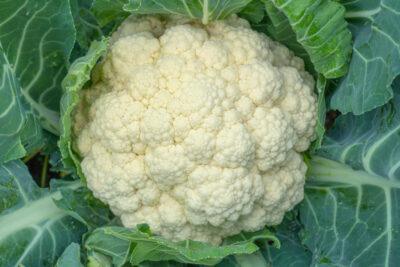
This Nutrient-Dense Crop is a “Must Grow”
In the ever-growing world of superfoods, cauliflower has taken a surprising and well-earned spotlight.
Once viewed as a bland side dish, this cruciferous vegetable has reinvented itself in modern kitchens—for good reason. Cauliflower is rich in nutrients and fiber, incredibly versatile, easy to grow, and loaded with potent compounds that promote better health.
A Storied Past with Humble Beginnings
Cauliflower may be back in style for the moment but it boasts a long and distinguished history. It’s believed to have first been cultivated around 600 B.C. in the region now known as Turkey.
From there, it spread throughout the Mediterranean and eventually made its way into the gardens of European nobility during the 1500s. By the time it reached France and England, cauliflower had earned its status as a delicacy.
Fast forward to today, and this once-elite vegetable is grown all over the globe. China, India, and the United States now lead the way in cauliflower production, thanks in part to its remarkable adaptability to different climates and soil types. That makes it a perfect candidate for backyard gardens, especially for gardeners seeking both beauty and nutrition in their plots.

Cauliflower is low in calories (just 25 per cup) but high in fiber, vitamins C and K, and essential plant compounds known for their protective health effects.
The Superfood Surge
Cauliflower’s recent resurgence in popularity has a lot to do with modern dietary trends. Low-carb, ketogenic, and plant-based diets have turned to cauliflower as a go-to replacement for everything from rice to pizza crust. But its rise to fame isn’t just about what it isn’t—it’s about what it is.
Cauliflower is low in calories (just 25 per cup) but high in fiber, vitamins C and K, and essential plant compounds known for their protective health effects. It fits seamlessly into nearly any meal plan, making it an ideal vegetable for families looking to eat healthier without sacrificing taste.
What Makes Cauliflower a Nutritional Powerhouse
What truly sets cauliflower apart are its bioactive compounds—natural substances that provide a wide range of health benefits. Chief among them is sulforaphane, a sulfur-rich compound that researchers have linked to powerful anti-cancer properties.
Another standout is indole-3-carbinol, which helps support the body’s natural detoxification processes and maintain hormonal balance.
Cauliflower also contains glucosinolates, which your body converts into compounds that help fight oxidative stress. Flavonoids like quercetin and kaempferol add to the vegetable’s anti-inflammatory, heart-protective qualities. Together, these compounds make cauliflower one of the most well-rounded superfoods you can grow.
Garden-to-Table Health Benefits
Including cauliflower in your home garden isn’t just about saving money or having fresh produce on hand—it’s a direct investment in your health. The fiber in cauliflower helps promote digestion and feeds beneficial gut bacteria, which is vital for overall wellness.
Its anti-inflammatory properties can help manage chronic conditions such as arthritis and cardiovascular disease.
Emerging studies suggest that compounds in cauliflower may inhibit the growth of certain cancer cells, particularly those associated with breast, prostate, and colon cancers. And because cauliflower is both low in calories and high in nutrients, it supports healthy weight management while keeping you feeling full and energized, providing health-conscious individuals with a reassuring reason to include it in their diet.
Growing Cauliflower: Easier Than You Think
Despite its fancy reputation, cauliflower is surprisingly easy to grow at home. It thrives in cool weather, making it an excellent choice for spring and fall gardens.
With well-drained soil, consistent moisture, and full sun, cauliflower can flourish in backyard plots and raised beds alike, giving home gardeners a reason to be excited about growing their own superfood.
There are also colorful varieties to consider, such as purple, orange, and green “broccoflower” cultivars. Not only do they add visual interest to your garden, but they also bring slightly different flavors and nutrient profiles to your plate.
Culinary Creativity at Its Best
Cauliflower’s neutral flavor and satisfying texture make it a blank canvas for culinary creativity. Whether you’re blending it into a creamy soup, roasting it with garlic and olive oil, or pulsing it into a rice-like grain substitute, this vegetable is a versatile ingredient that can inspire a wide range of dishes.
Modern favorites include cauliflower rice stir-fry, buffalo-style cauliflower bites, and plant-based curries loaded with anti-inflammatory spices like turmeric and cumin. You can even use it to make gluten-free pizza crust or as a low-carb base for mashed “potatoes.”
Cauliflower Isn’t Just a Trend—It’s a Smart Choice
From its ancient origins to its current superfood status, cauliflower continues to prove its value in the garden and on the table. It’s a nutritional powerhouse, a culinary chameleon, and an easy-to-grow vegetable that belongs in every backyard this season.
Whether focused on eating healthier, experimenting in the kitchen, or simply growing your own food, cauliflower offers a rewarding and health-boosting addition to your gardening plans. So this year, get your seeds and give cauliflower the space it deserves—and watch it transform both your garden and your meals.
 Off The Grid News Better Ideas For Off The Grid Living
Off The Grid News Better Ideas For Off The Grid Living




